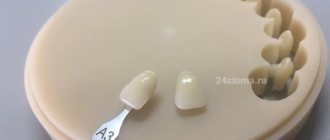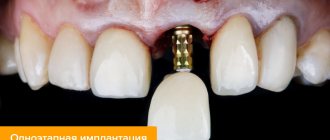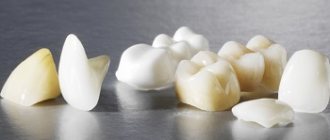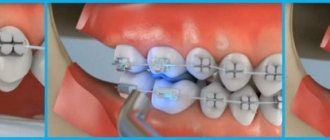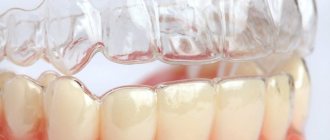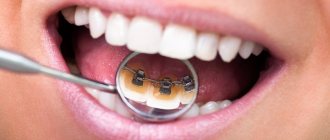Temporary dental crowns are crowns made from inexpensive materials that are used during prosthetics only to protect teeth until permanent crowns are installed.
The purpose of using temporary crowns is to strengthen teeth and give them a natural appearance.
Such crowns are not very stable and have limited aesthetics. They are installed on a previously ground tooth or on an implant.
In what cases are temporary crowns installed?
- When a tooth is chipped or completely lost.
- After root canal treatment.
- In the case where caries has led to weakening and destruction of the tooth crown.
- After implantation.
Why are temporary crowns needed?
Before installing a permanent crown on a tooth, you must wait until the mucous membrane has healed. To protect the oral cavity from bacterial infections during this time, temporary crowns were created.
The dentist places a crown, which is bonded to the tooth with special temporary cement so that it can be easily removed when the final crown is ready.
Why is it necessary to put a temporary crown on your teeth?
- A temporary crown protects the ground tooth and ensures patient comfort while ensuring proper aesthetics.
- Preserving the aesthetics of a smile. Temporary crowns are especially often used to cover missing front teeth.
- Protection against hypersensitivity. A ground tooth without enamel protection is sensitive to the pain of temperature changes.
- Bite stabilization. A temporary crown prevents the remaining teeth from shifting.
- Protection of periodontal tissues. A temporary crown is necessary to prevent gingivitis.
- Protection against bacteria arising in the oral cavity.
Why do you really need temporary plastic crowns?
Dental restoration is a painstaking, thorough, one might say, jewelry work. Each stage of the process affects the result. One of these steps in highly aesthetic prosthetics is the installation of temporary or diagnostic crowns.
Any patient who comes to me to restore several teeth is concerned with the question: will everything work out as planned? Moreover, most people are far from dentistry, and many stages of treatment do not seem entirely clear. As a doctor, I perfectly understand the doubts of my patients and always share the secrets of each stage of the recovery technique. For example, sometimes patients ask whether temporary crowns are really necessary? And if the front teeth are not there, is it possible to do without them?
I have two answers to these questions. First, short: temporary crowns are a mandatory stage of prosthetics. And the second, more detailed. I invite you to think about it together.
Imagine that a person has been missing several teeth for a long time. This situation disrupts the entire architecture of the oral cavity. An asymmetrical load occurs on the temporomandibular joint (TMJ), which causes disturbances in the functioning of the facial muscles. Some of them are overly tense, while other muscle groups, on the contrary, do not receive enough load. The body adapts to this situation as best it can. True, at the cost of changing the oval of the face, the condition of the muscles and blood vessels. Because the dentofacial apparatus is a frame for the face and neck. And any imbalance with the teeth leads to changes in muscle function.
Now let’s assume that the patient has been missing a sufficient number of chewing teeth for more than five years. We installed implants, and at the patient’s request, we immediately made permanent prosthetics: instead of missing teeth, we installed new, permanent ones. It would seem that everything should get better quickly. But no. Because the joint, adapted to the absence of teeth, is accustomed to maintaining a small distance between the jaws. And after the installation of new teeth, the jaws will begin to press on each other more than usual. This can cause increased muscle tension, and then the appearance of persistent pain in the facial, parotid or cervical-occipital areas.
In addition to discomfort and pain, there may be other troubles, for example, chips or cracks in the crowns, which will require their complete replacement. If the crowns are made of zirconium dioxide, then such an imbalance can lead to the loss of other teeth and damage the TMJ. Zirconium dioxide is very durable, and if the height of the crowns is too high (this happens when the installation is carried out without diagnostics/trying on using temporary crowns), significant problems with the gum bone and the gum itself can begin.
To avoid such a quick but disservice, temporary, or rather diagnostic, crowns are needed before permanent prosthetics. They will help gradually return muscles and joints to the correct position. They will also allow you to avoid injuries and chipped teeth, damage to the cheeks from the inside due to incorrect alignment of the dentition.
Such crowns are made of special plastic (ethyl methacrylate, bisacrylate). This is a short-lived material; removable plastic dentures are made from it, although the technique is outdated. Because such prostheses cannot last long and constantly require replacement. But for temporary crowns this is an excellent material, because it is good both for aesthetics and for rehearsal before permanent prosthetics. For temporary crowns, a diagnostic function is important - they help to understand how correctly the shape and color of the teeth are chosen. They also make you feel the correct relationship of the dentition and changes in the functioning of the entire dentofacial apparatus.
Thus, the idea that temporary crowns are needed only for prosthetic restorations of the front teeth is erroneous. They are necessary not only for the ability to smile while the implant takes root or the permanent ones are made. Their functions are more important: they help to adapt to the new relationship of teeth, adjust their color, shape and height.
If we summarize all the possibilities of temporary crowns, they solve several significant problems:
1. Protect the tooth pulp and prepared gum surfaces. Essentially they protect tissue instead of permanent teeth.
2. Prevent the prepared teeth from changing their position and “floating.” The relative position of the dentition is normalized. The contour of the adjacent gum is modeled, which will help to obtain an accurate impression.
3. Restore the alveolar ridge and form the correct bed for a permanent crown during prosthetics on implants.
4. Restore chewing and aesthetics.
5. Help to test future permanent orthopedic structures in reality. This is not only a fitting with an assessment of shape and color, but also an understanding of how comfortable the new teeth will be, how they affect diction, whether anything in the gum area is interfering, what the lips and cheeks look like at rest and with a new smile.
Taking care of the patient's comfort is important to me. The success of the entire treatment depends on the quality of contact with him. Together we determine how comfortable the location is, and whether the crowns interfere with the closure of teeth, chewing, and smiling. My patients always know that if they feel that the temporary crowns are somehow not positioned correctly, are uncomfortable with them, or have a feeling that they are uncomfortable, then it is worth sharing their doubts. Comfortable prosthetics are needed to identify all possible problems and eliminate them. In my opinion, thinking about everything in advance, calculating, discussing, checking - this is real care for the patient.
But well-made plastic temporary crowns also have a downside. Sometimes patients get so used to them that they don’t want to change. Therefore, I want to answer another important question: how long can you wear temporary crowns?
It all depends on the expected amount of work and the number of prosthetic teeth. If a small volume is planned, then a few weeks are enough. In cases where a large number of teeth are missing for a long time, they can be worn for up to a year. Then they are made in a dental laboratory, and repositioned in the oral cavity and, if necessary, adjusted. Even heavy-duty plastic cannot last longer than a year. Therefore, temporary crowns will need to be replaced with permanent ones, for example, E-max. If permanent prosthetics are not done in time, the result may be lost. Changed crowns, as well as damaged teeth, begin to affect the condition of the entire architecture of the oral cavity.
Therefore, if the time has come to replace temporary crowns, part with them without regret, that’s why they are temporary. Or more precisely, diagnostic ones, necessary to get excellent results during implantation and production of veneers.
After the relationship of the dentition has been restored, the teeth are closed correctly and there is no discomfort, you can proceed to the next stage: installing permanent structures. They will fit perfectly against each other, without chips or cracks. Which will normalize the bite, the functioning of the TMJ, the oval of the face and will be the beginning of a new life.
Since dental restoration is a scrupulous job, when choosing a doctor and clinic for implant prosthetics or conventional prosthetics, it is very important to pay attention to whether the doctor uses the technique of installing temporary (diagnostic crowns). At Smileguru Clinic, we care about the patient’s comfort not only at the time of treatment, but also in subsequent years. And my goal as a specialist is to achieve long-term results. So that the patient comes to us after treatment only for medical examinations.
Tsyren Badmaevich Badmaev
Chief physician - dental surgeon, implantologist, orthopedist
Installation of a temporary crown
The placement of a temporary crown is usually completed in one visit to the dental office. The installation process takes about 10-30 minutes. The procedure is painless. Grinding and correction of teeth are performed under local anesthesia.
First, the dentist prepares the tooth for a permanent crown. The tooth surface is ground down approximately 1-2 mm on each side.
Impressions of the teeth are then created. They are sent to a dental prosthetics laboratory, where permanent crowns are created.
While they are being made, the patient is given a temporary plastic crown. Once the dentist has received the finished permanent crown, he places it on the patient's tooth.
During the first days after the procedure, the patient may feel discomfort because the shape of the tooth with a temporary crown may be slightly different from what it was before.
Possible complications and side effects after the procedure:
- Discomfort
- Tooth sensitivity
- Allergic reaction
Manufacturing Features
Two methods are used to produce a temporary structure:
- The direct method involves making the structure directly during the appointment, that is, temporary crowns are fixed immediately after turning. This preserves psychological comfort for the Patient and increases convenience. To make an impression, silicone is used, which hardens quickly and eliminates discomfort during processing. Dental cement is used for fastening, which allows the device to be held securely and without displacement.
- The indirect method differs in that it takes a couple of days to produce. First, a cast is made, then a plaster model. Based on this design, a temporary product is made.
In the first case, installation takes up to one hour. The doctor follows these steps:
- the surface of the row is prepared, after which an impression is taken;
- the unit to be restored is ground;
- a stump is formed, which is necessary for fixing the future crown;
- pouring the mixture into the cast, forming the future product;
- after curing, the shape is adjusted;
- At the last stage, the finished model is attached to cement.
The direct method is chosen more often than others. It is simple, does not require much time, but allows you to work with no more than three units at a time.
Advantages
The advantages of using PMMA prostheses as temporary ones include:
- the appearance imitates natural fabrics, has suitable light transmission and shade;
- strength, ability to withstand bending and compressive loads;
- safety for the Patient, hypoallergenic;
- The service life is long, which allows you to wear such crowns for the entire period of production of permanent ones.
The use of such material provides greater comfort and strength is higher than that of commonly used plastics. The wearing period is long, usually the protocol requires about six months, but the properties of the material allow you to use the device for a year and a half or more without any problems. If you follow the rules of hygiene, there will be no inconvenience or loss of shade.
Despite the high aesthetic properties, the appearance of the device is still different from natural teeth. Therefore, it is not recommended to use it for long-term wear for the frontal area. Permanent use is indicated in the following cases:
- if there is rejection of other materials used for prosthetics;
- if you are allergic to alloys and metal components.
At the same time, lightness, comfort in use, resistance to damage and abrasion are noted. The material can withstand chewing loads and corrosive effects.
Prices
The cost of prosthetics depends on the materials and type of structure used. Our clinic offers the following rates:
- lumineers – 12-30 thousand rubles;
- tabs – 3-17 thousand rubles;
- ceramic and metal-ceramic crowns – 15 and 4.5-17 thousand rubles, respectively;
- implants – 20-45 thousand rubles.
To calculate the cost, it is recommended to undergo an initial examination and examination by a doctor, who will select a design in accordance with the problem and the condition of the oral cavity. When choosing temporary PMMA crowns, the oral cavity is first examined and prepared, after which the structure is manufactured and fixed.
About Us
My Ort Dentistry Clinic offers surgical treatment, prosthetics and diagnostic services. One of the services is the installation of temporary PMMA crowns, used to maintain aesthetics and functionality while permanent structures are being manufactured. Doctors will also conduct a full diagnostic examination and preparation; after prosthetics, observation and control of the condition of the tissues will be carried out.
Patients are offered the following benefits:
- qualified doctors with extensive experience in prosthetics with various systems;
- modern dental equipment, including diagnostic equipment;
- high-quality materials certified in the Russian Federation;
- favorable prices for services;
- guarantee of reliability and quality.
To make an appointment with My Ort doctors, please contact us by phone +7 (812) 454-45-50 or leave a request on the website, specifying a convenient time to visit the clinic. You can also ask questions by sending a request to the clinic’s email
Tips for using temporary crowns
- Some foods will stick to the temporary crown, so please avoid chewing gum or other sweets and foods.
- Avoid chewing on the side of your jaw where the temporary crown was placed.
- Try to minimize your consumption of hard foods (such as vegetables), which can break the crown.
- Temporary crowns do not last long. Sometimes they may crack, break or fall out. If this happens to you, please contact us immediately, bring the crown with you, we will reinstall it or replace it.
- Do not remove the temporary crown from your mouth. Without it, your teeth may shift and the target crown may not fit.
- Don't brush too hard on a tooth with a temporary crown, and be careful with floss.
